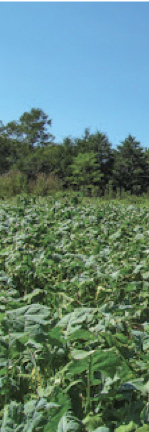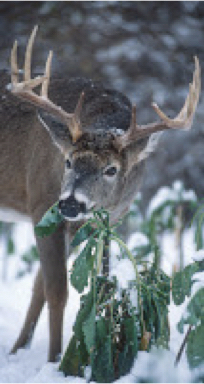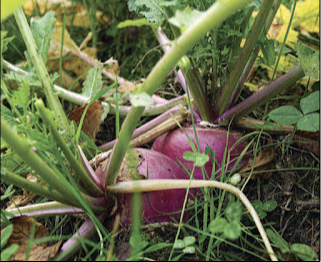The Many Benefits of Brassicas
By Gerald Almy

Brassicas might be the perfect plant for food plots from fall through winter. Maybe that’s not an exact quote, but such statements were common when these large-leaved, bluish-green plants burst onto the food plot scene when the Whitetail Institute first introduced them as part of their No-Plow blend. Brassicas were especially praised as the ultimate late-season forage for attracting and feeding deer and also providing important benefits for the soil and environment.
I wasn’t in the mood for such testimonials the first time I planted this forage on my 117 acres. To me, the  experience was akin to a football team that starts 0 in 3. Maybe the season won’t be a failure but began to look that way. Sure, my plot of Winter-Greens came up quickly. And it wasn’t much trouble to plant. I just spread the tiny seeds on a smooth, firm soil bed, cultipacked it lightly and waited. When it was up, the field grew fast, even with sparse rains. But the most important question was what the deer thought about it. They walked past that plot to access my other planting, Imperial Whitetail Clover. Others fed in a Whitetail Oats Plus plot nearby while casting a wary eye toward the new food. Things changed suddenly in early October. A hunt in another province took me away for a while. When I returned, the Winter-Greens plot had been hammered. It was hard to believe that was the same half-acre that had 2-foot-tall plants when I left town. That evening, although much of the plot was gone, deer still worked on the remaining plants. Better, later in the week, I connected on one of my best bucks ever on that new forage — a heavy-beamed 10-pointer. That’s the way it is on some properties with brassicas. Sometimes, deer just don’t seem attracted to this food immediately. But when frosty nights arrive, starches in those plants convert to sugars, and the large, tender leaves suddenly have a strong appeal to whitetails. Picture a bowl of cereal. It’s kind of bland. But sprinkle on a bit of sugar and a few slices of banana, and the product suddenly becomes palatable. (My apologies to health fanatics; I still need a touch of sugar on my Wheaties.) The good thing about brassicas is that when deer taste the plants after the sugar content has increased, they’ll hit them hard the next season and every season thereafter, oftentimes before any frost affects the plants. Sure, more deer will flock to brassicas after cold snaps but deer will also eat some brassicas in the early season as well.
experience was akin to a football team that starts 0 in 3. Maybe the season won’t be a failure but began to look that way. Sure, my plot of Winter-Greens came up quickly. And it wasn’t much trouble to plant. I just spread the tiny seeds on a smooth, firm soil bed, cultipacked it lightly and waited. When it was up, the field grew fast, even with sparse rains. But the most important question was what the deer thought about it. They walked past that plot to access my other planting, Imperial Whitetail Clover. Others fed in a Whitetail Oats Plus plot nearby while casting a wary eye toward the new food. Things changed suddenly in early October. A hunt in another province took me away for a while. When I returned, the Winter-Greens plot had been hammered. It was hard to believe that was the same half-acre that had 2-foot-tall plants when I left town. That evening, although much of the plot was gone, deer still worked on the remaining plants. Better, later in the week, I connected on one of my best bucks ever on that new forage — a heavy-beamed 10-pointer. That’s the way it is on some properties with brassicas. Sometimes, deer just don’t seem attracted to this food immediately. But when frosty nights arrive, starches in those plants convert to sugars, and the large, tender leaves suddenly have a strong appeal to whitetails. Picture a bowl of cereal. It’s kind of bland. But sprinkle on a bit of sugar and a few slices of banana, and the product suddenly becomes palatable. (My apologies to health fanatics; I still need a touch of sugar on my Wheaties.) The good thing about brassicas is that when deer taste the plants after the sugar content has increased, they’ll hit them hard the next season and every season thereafter, oftentimes before any frost affects the plants. Sure, more deer will flock to brassicas after cold snaps but deer will also eat some brassicas in the early season as well.
 Benefits of Brassicas “Brassica crops have a number of beneficial attributes,” according to the United States Department of Agriculture. “These include rapid fall growth, high biomass production, a well-developed taproot, excellent nutrient-scavenging ability, competitiveness with other plants and special pest-resistance capabilities.” Further, these plants are also great for reducing erosion and topsoil loss on sloped land. Brassicas are high in digestible fiber, selenium and vitamin C and with their huge leaves, each plant offers a large amount of food to deer. One of the most important benefits of Whitetail Institute brassicas is their large size and height. That makes them readily accessible even under deep snow. Even if deer demolish the green tops, the Whitetail Institute’s brassica products, Winter-Greens, Beets & Greens and Tall Tine Tubers also have tubers deer will dig up and consume in late winter. If you have grown food plots for several years with only disking or tilling between planting your soil is likely compacted. The plants you sow might do OK, but they probably can’t dig down beyond the first few inches to obtain moisture or nutrients — a condition called hardpan. Brassicas offer a perfect way to correct this, short of deep plowing. Many of the tubers in these seed blends grow a deep taproot that breaks up soil, drilling right through hardpan. This helps break up dense soil, alleviates compaction and aerates the dirt, allowing oxygen and moisture to penetrate. So, plant brassicas for deer and hunting, but also plant them for the health of your soil.
Benefits of Brassicas “Brassica crops have a number of beneficial attributes,” according to the United States Department of Agriculture. “These include rapid fall growth, high biomass production, a well-developed taproot, excellent nutrient-scavenging ability, competitiveness with other plants and special pest-resistance capabilities.” Further, these plants are also great for reducing erosion and topsoil loss on sloped land. Brassicas are high in digestible fiber, selenium and vitamin C and with their huge leaves, each plant offers a large amount of food to deer. One of the most important benefits of Whitetail Institute brassicas is their large size and height. That makes them readily accessible even under deep snow. Even if deer demolish the green tops, the Whitetail Institute’s brassica products, Winter-Greens, Beets & Greens and Tall Tine Tubers also have tubers deer will dig up and consume in late winter. If you have grown food plots for several years with only disking or tilling between planting your soil is likely compacted. The plants you sow might do OK, but they probably can’t dig down beyond the first few inches to obtain moisture or nutrients — a condition called hardpan. Brassicas offer a perfect way to correct this, short of deep plowing. Many of the tubers in these seed blends grow a deep taproot that breaks up soil, drilling right through hardpan. This helps break up dense soil, alleviates compaction and aerates the dirt, allowing oxygen and moisture to penetrate. So, plant brassicas for deer and hunting, but also plant them for the health of your soil.
Weed Weapon In my three-decades plus of food plotting, I’d say controlling weeds and grasses is the No. 1 challenge. That brings up another benefit of Whitetail Institute brassicas. These brassicas grow so aggressively they choke out most unwanted weeds and grasses. They offer a great way to prepare a plot for a future planting of a perennial, such as Alfa Rack Plus, Imperial Whitetail Clover, Fusion or Chic Magnet.
WINA Brassica Products: Which Ones to Plant? The Whitetail Institute has many products that include brassicas. The ones I have turned to most often are Tall Tine Tubers and Winter-Greens. The first contains a mixture of the best turnip varieties deer prefer, including the company’s proprietary Tall Tine Turnip. Winter-Greens also includes Tall Tine Turnips and the Whitetail Institute’s WINA 210 kale. This kale was found to be four times more attractive than other kales in side-by-side field tests and is very cold tolerant. These seed blends along with Beets & Greens, should be the backbone plantings for your brassica program. The Institute’s brassica products contain mixtures of plants so one component is always reaching peak palatability or growth, taking pressure off other plants in the blend and ensuring that one plant doesn’t crowd out others. This variety also offers something to appeal to deer throughout the hunting season. Vision is an excellent choice if you want a year-round perennial plot with some brassica mixed in for extra appeal during hunting season. The clover and chicory offer nearly year-round attraction, and the WINA 210 kale provides forage in fall and through the coldest months. For kill plots in the woods and areas that can’t be worked extensively with heavy equipment, Bow Stand and Secret Spot are perfect choices. On larger fields you can plow and prepare, Pure Attraction is a top choice of brassicas mixed with Whitetail Oats. The tender oats offer early attraction, and the brassicas become even more attractive later after the first frost.
Planting Brassicas It’s optional but you can kill off existing vegetation with a non-selective herbicide first. Whether you decide to spray or not, till the soil and prepare a smooth seedbed. Cultipack it or use a weighted fence-type drag to smooth the bed. Then broadcast the seeds at the recommended rate. If you used a drag to smooth the plot, simply spread the seeds and do nothing else. If the plot was firmed with a cultipacker, go over it again with a cultipacker after seeding for good seed-to-soil contact. A final piece of advice is to always rotate your annual plots between various types of plants. Never plant brassicas more than two consecutive years to avoid poorer performing plots. Give some of the Whitetail Institute brassica seed mixtures a try if you haven’t already. You and your deer will be glad you did and after the first frost of fall arrive, make sure you are on a stand with an arrow knocked or your finger on the safety of your firearm.
